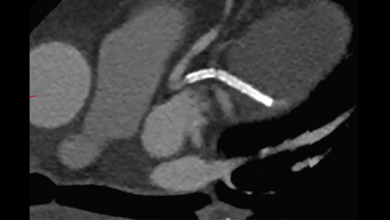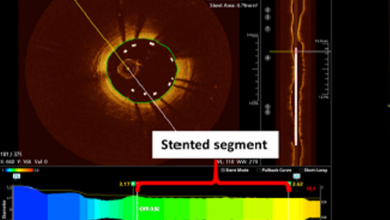Search results
Author(s):
Morton J Kern
,
Katherine M Yu
Added:
3 years ago
Coronary artery disease (CAD), the most common cause of morbidity and mortality in the US, is frequently identified by coronary angiography. Decisions for treatment are often based on angiography alone, absent other clinical indicators for intervention. However, by angiography alone, conventional wisdom has suggested that a coronary stenosis is significant if there is at least a 50 % diameter…
View more
Author(s):
Masahiro Natsuaki
Added:
7 months ago
ESC 23 — Dr Masahiro Natsuaki (Saga University, JP) discusses the short and optimal duration of dual antiplatelet therapy-3 Study (STOPDAPT-3) (NCT04609111).
In the STOPDAPT-2 study, 1-month dual antiplatelet therapy (DAPT) followed by clopidogrel monotherapy was shown to provide benefits in bleeding reduction over a 12-month period, however, other trials have shown high rates of bleeding at…
View more
Author(s):
Duraisamy Balaguru
,
Rajiv Verma
Added:
3 years ago
Surgical repair has been the cornerstone of treatment for congenital heart diseases (CHD). However, cardiac catheterization has evolved from being a diagnostic modality to a therapeutic one in the past four decades. Application of catheter-based therapy has become the standard of care for some congenital heart defects, thus obviating surgery. This review will discuss congenital heart defects that…
View more
Author(s):
Antonio Gutierrez
,
Sunil V Rao
Added:
3 years ago
Current evidence-based therapies for ischemic heart disease include antithrombotic and antiplatelet medications that reduce the risk for ischemic outcomes such as myocardial infarction and stroke.1 Given their mechanism of action, bleeding is a risk with these agents, especially when combined with invasive procedures.2 In addition to overt bleeding, clinical trials of antithrombotic strategies…
View more
Author(s):
Tasveer Khawaja
,
Scott Janus
,
Sadeer G Al-Kindi
Added:
1 year ago
Author(s):
Rani Upadhyay
,
Hussayn Alrayes
,
Scott Arno
,
et al
Added:
2 years ago
Author(s):
Michael Megaly
,
Marwan Saad
,
Emmanouil S Brilakis
Added:
3 years ago
Percutaneous coronary intervention (PCI) of small-vessel coronary artery disease (SVD) is challenging because of difficulties with equipment delivery and high restenosis rates. Drug-coated balloons (DCBs) are an attractive emerging PCI option for patients with SVD.
Small-vessel coronary artery disease
SVD was defined in the Intracoronary Stenting or Angioplasty for Restenosis Reduction in Small…
View more
Author(s):
David Holmes Jr
Added:
3 years ago
Percutaneous coronary revascularization has revolutionized modern cardiovascular care. It has become one of the most well-studied and frequently performed procedures in modern medicine and is currently performed in more than 900,000 patients per year, exceeding the rate of coronary bypass surgery. It is used in an increasingly large number of patient subsets and used to treat an increasingly…
View more
The Impact of Haemorrhagic Complications on Mortality in Acute Coronary Syndromes—Implications for…
Author(s):
Steven V Manoukian
,
Michele D Voeltz
,
Frederick Feit
Added:
3 years ago
Article
Author(s):
Jelmer Westra
,
Shengxian Tu
Added:
3 years ago
Physiological lesion assessment is recommended for the identification of intermediate coronary lesions that might benefit from percutaneous coronary intervention (PCI).1 The quantitative flow ratio (QFR) was developed to derive coronary physiology from angiographic images, whereas the optical flow ratio (OFR) is a more recent approach for the rapid and automated assessment of coronary physiology…
View more













 « First
« First